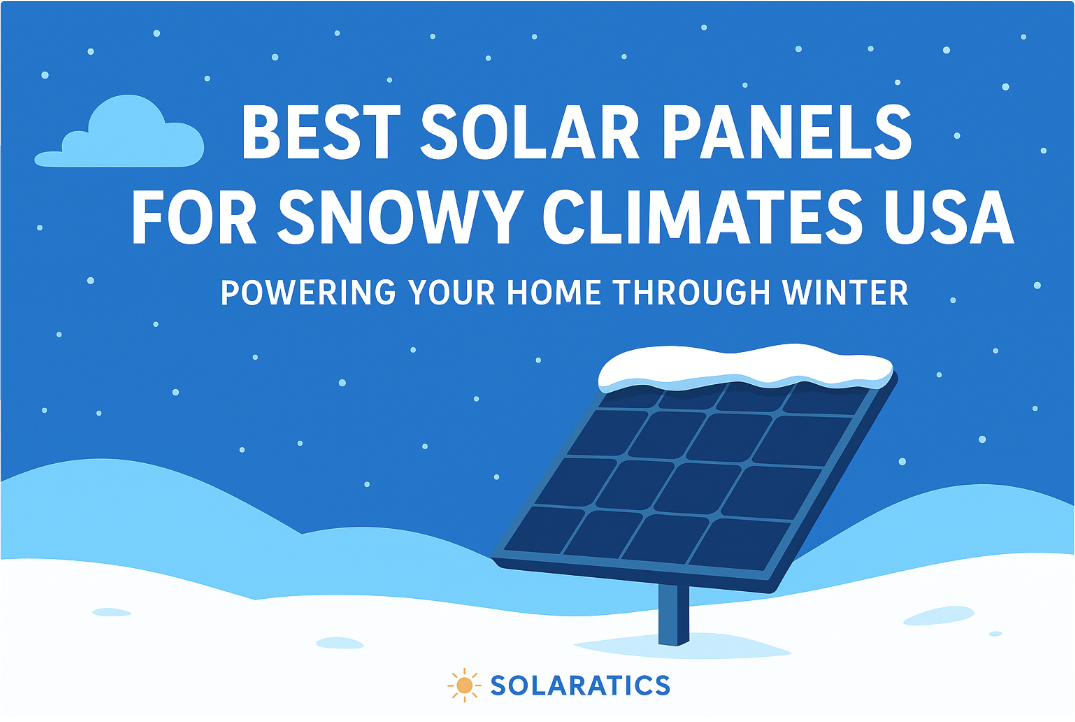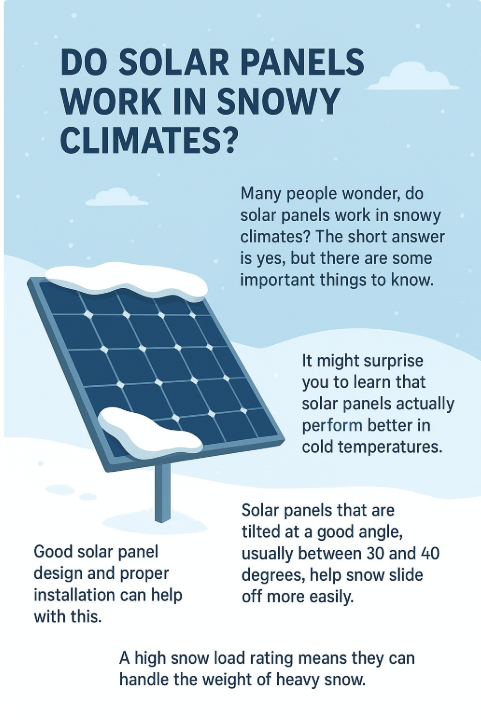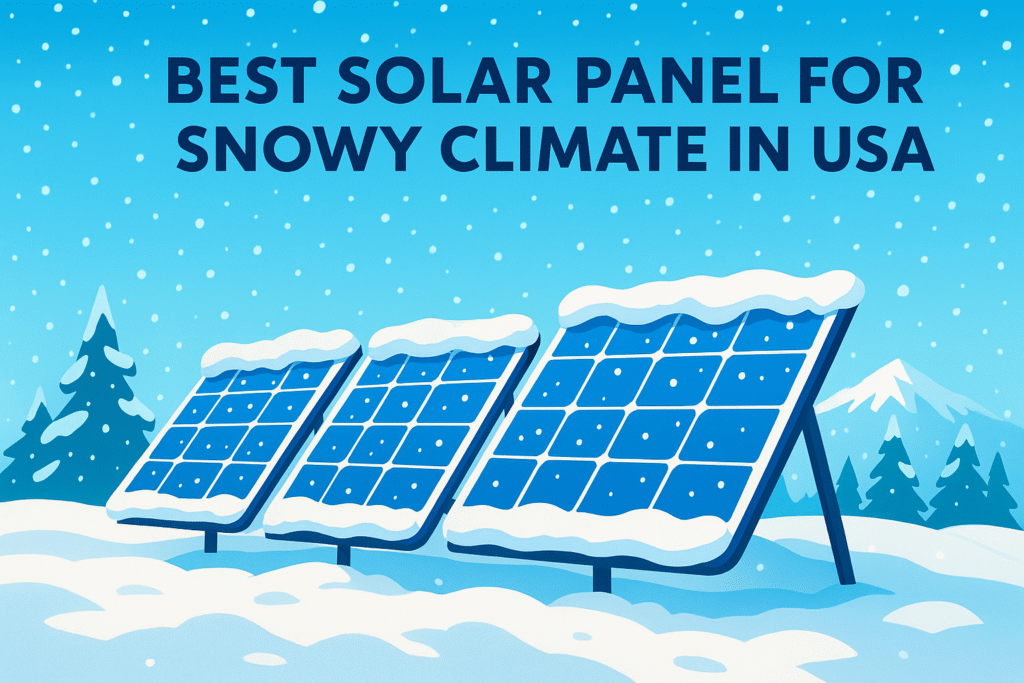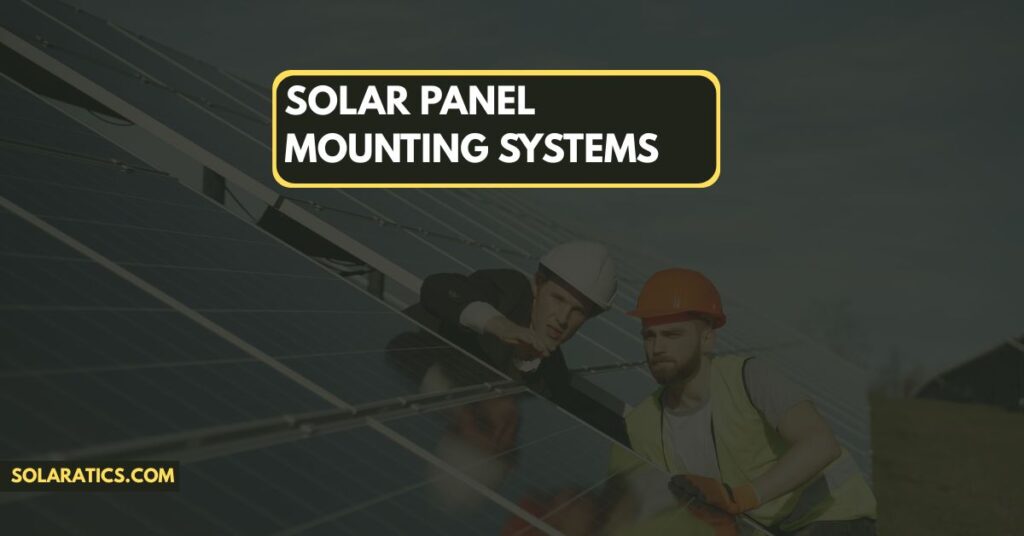Best Solar Panels for Snowy Climates USA: Powering Your Home Through Winter

Choosing the best solar panels for snowy climates USA is a smart move for homeowners in areas that see a lot of snow. You might wonder if solar panels even work when it snows. Don’t worry; we’ll explain why solar power is still a great option, even if you live in a place with cold and snowy winters.
We’ll help you understand what to look for when buying solar panels, how to install them correctly, and how to keep them working well when it’s snowing. By the end of this post, you’ll know which solar panels are the best for snowy weather, and you’ll feel confident about using solar energy to power your home all year round.
Do Solar Panels Work in Snowy Climates?
Many people wonder, Do solar panels work in snowy climates? The short answer is yes, but there are some important things to know. Snow can cover the panels and stop them from making electricity. However, good solar panel design and proper installation can help with this.

One key thing is how well the snow slides off the panels. Solar panels that are tilted at a good angle, usually between 30 and 40 degrees, help snow slide off more easily. Also, some panels have special glass coatings that make it harder for snow to stick. This snow shedding design is very important for keeping your panels working during the winter.
It might surprise you to learn that solar panels perform better in cold temperatures. That’s because the cold helps the electrons inside the solar cells move more easily, which means they can produce more electricity. So, while snow covering the panels is a problem, the cold itself is good for solar panel efficiency. This addresses some common worries, like do solar panels work in winter USA. Yes, they do, and sometimes even better in the cold!
It’s also important to clarify some misunderstandings. For example, many people think that snow will ruin their solar panels or make them work very poorly. This isn’t true if the panels are strong enough and if you take care of them properly. Good quality panels have a high snow load rating, which means they can handle the weight of heavy snow. So, while you might need to clear snow off your panels sometimes, the snow itself won’t usually damage them or completely stop them from working. Understanding solar efficiency in snow and solar panels ‘ cold-weather performance helps clear up these worries and shows that solar power is a reliable option even in snowy parts of the USA.
Key Features to Look for in Solar Panels for Snowy Regions
When you’re looking for solar panels to use in a snowy area, it’s important to choose ones that are built to handle the cold and heavy snow. The right features will make sure your panels last longer and work better all winter long.
1. High Snow Load Rating
The high snow load rating is a crucial number to verify. It tells you how much weight the panels can handle from snow and ice. In snowy areas, you need panels that can withstand a significant amount of weight without being damaged. The importance of durability is key to a long-lasting solar system.
2. Temperature Coefficient
The temperature coefficient is another critical feature. This number shows how well the panels perform in cold weather. A lower temperature coefficient means the panels won’t lose as much efficiency when temperatures drop. Interestingly, solar panels work better in the cold, so a good temperature coefficient ensures they stay highly efficient even on chilly, sunny days.
3. Glass Coating and Snow Shedding
Look for panels with special glass coating & self-cleaning properties. These coatings help snow slide off more easily. Some panels have a hydrophobic coating, which means they repel water and can help prevent ice from building up. This feature is great for snow sliding off your panels, which means less work for you and more energy production.
If you are looking for the best product to protect your Panels, you should check out Glass Gleam Solar – Solar Panel Cleaner – Highly Concentrated
4. Monocrystalline vs. Polycrystalline
When comparing monocrystalline vs. polycrystalline in cold climates, remember that monocrystalline panels are generally more efficient. They also tend to work better in low-light conditions, which is helpful during shorter winter days. However, good quality polycrystalline panels can still be a solid choice for snowy regions if they have other key features, like a high snow load rating.
5. Warranty and Build Quality
Finally, pay close attention to the warranty & build quality. Panels meant for tough weather need to be extra strong. A long warranty is a good sign that the company trusts its product to handle harsh conditions. Make sure the panels are made of durable materials and are specifically designed to be robust winter solar panels USA. The best type of solar panels for snow will have all of these features to ensure they perform well for many years.

SOLARATICS.COM
Best Solar Panels for Snowy Climates in the USA (2025 List)
Choosing the right solar panels for snowy areas is important. Here are some of the Top 5 Best Solar Panels 2025 that are great for handling snow and cold weather in the USA. This Comparison Table will help you see their key features:
| Brand | Snow Load Rating (lbs/ft²) | Efficiency % | Warranty (years) | Why it’s Good for Snow Regions |
|---|---|---|---|---|
| SunPower X-Series | 540 | 22.8% | 25 | Best efficiency and durability |
| LG NeON R | 540 | 21.7% | 25 | Strong cold-weather performance and high load capacity |
| Panasonic HIT Panels | 540 | 21.6% | 25 | Excellent snow-shedding capabilities |
| Q CELLS Q.PEAK DUO | 540 | 20.9% | 25 | Budget-friendly yet reliable in winter |
| REC Alpha Pure Series | 560 | 21.7% | 25 | Durable and performs well in snow |
Let’s look closer at each of these:
SunPower X-Series: These panels are known for having the best efficiency. They are also very durable, which is important for handling snow and ice. With a snow load rating of 50 lbs/ft², they can handle a lot of weight. Their high efficiency % of 22.3% means you’ll get more power even when sunlight is limited in the winter. Plus, they come with a long warranty of 25 years, giving you peace of mind. Their overall quality makes them great for snowy regions.
LG NeON R: LG’s NeON R panels are also a top choice. They are strong in cold temperatures and have a high snow load capacity of 54 lbs/ft². Their efficiency % is also high at 21.7. Like SunPower, they offer a 25-year warranty. These panels are known for being very reliable, even in harsh winter conditions.
Panasonic HIT Panels: Panasonic’s HIT panels have a snow load rating of 40 lbs/ft². Their efficiency % is 20.6, and they also have a 25-year warranty. What makes these panels stand out for snowy climates is their excellent snow shedding. The way they are designed, with a unique frame and surface, helps snow slide off more easily, which means less power loss during snowfall.
Q CELLS Q.PEAK DUO: If you’re looking for something more budget-friendly that still performs well in winter, Q CELLS Q.PEAK DUO panels are a good option. They have a strong snow load rating of 50 lbs/ft² and an efficiency % of 20.1. They also come with a 25-year warranty and are known for being reliable in winter conditions. They offer a good balance of performance and cost.
REC Alpha Pure Series: These panels are very durable, with an impressive snow load rating of 70 lbs/ft², the highest on this list. Their efficiency % is also great at 21.9, and they come with a 25-year warranty. The REC Alpha Pure Series offers good winter performance and can handle very heavy snow loads, making them a solid choice for the snowiest areas.
When choosing your panels, remember to consider these factors along with your specific needs and budget. Looking at real data and reviews can also help you make the best decision for your home in a snowy climate.
Best Solar Panel Mounting Systems for Snowy Climates

Having the right mounting system is just as important as choosing the right solar panels for snowy areas. The way your panels are mounted can greatly affect how well they handle snow and produce energy in the winter.
One of the most important things to consider is the tilt angle. For snowy regions, it’s generally recommended to have a tilt angle of 30–40° for snow shedding. A steeper angle helps gravity pull the snow off the panels more easily, preventing it from piling up and blocking sunlight.
You also need to think about whether ground-mounted vs. roof-mounted systems are better for your situation, especially in snow-heavy states. Roof-mounted systems are common, but in areas with very heavy snowfall, ground-mounted systems can offer some advantages. They can often be installed at a more optimal tilt angle for snow shedding and can be easier to access for manual snow removal if needed. However, they might take up more space on your property.
Regardless of whether you choose a roof-mounted or ground-mounted system, the importance of strong racking systems for high snow loads cannot be overstated. The racking system is what holds your panels in place, and it needs to be strong enough to support the weight of heavy snow and ice. Make sure to choose a racking system that is specifically designed for high snow loads and is certified to meet local building codes. This ensures the safety and longevity of your solar installation. Considering the ideal solar panel angle for snow and the best solar mounting USA winter options will help you set up a system that can effectively handle the challenges of a snowy climate.
How to Maintain Solar Panels in Snowy Weather
Even with the best solar panels and mounting systems, some maintenance is needed in snowy weather to keep your system working efficiently. Here are some tips on how to maintain solar panels in snowy weather.
One important thing is safe snow removal. If heavy snow has covered your panels and isn’t sliding off on its own, you might need to remove it. However, it’s crucial to do this safely and without damaging the panels. Avoid using metal tools or anything abrasive that could scratch the glass. A soft brush or a roof rake with a soft end can be used to gently sweep the snow off. Be very careful when working on a roof, especially in icy conditions, or consider hiring a professional for snow removal.
Some people also look into automated snow-melting systems. These can include heated panels or hydrophobic coatings. Heated panels have built-in elements that can melt snow and ice, while hydrophobic coatings are designed to repel water and snow, making it easier for them to slide off. These systems can reduce the need for manual snow removal but may add to the initial cost.
It’s also a good idea to know how often to check panels in winter. After heavy snowfalls or ice storms, take a look at your panels (from the ground, if it’s safe) to see if they are covered. If there’s a significant build-up of snow that isn’t melting or sliding off within a day or two of sunny weather, you might need to take action. Regularly monitoring your system’s energy production can also give you an idea of whether the snow cover is significantly impacting performance. Understanding how to clean solar panels in snow and the general principles of solar maintenance USA winter will help you keep your system running smoothly throughout the cold season.
Cost Considerations for Solar in Snowy Regions (USA-Specific)
Thinking about going solar in a snowy region of the USA involves considering some specific costs and savings. The cost per watt in snowy states, such as Minnesota, New York, and Colorado, can sometimes be slightly higher than in sunnier states due to the need for more robust equipment and potentially more complex installation to handle snow loads and specific mounting requirements.
However, there are also state-specific incentives/rebates for snowy climate regions that can help offset these costs. Many states with renewable energy goals offer financial incentives, tax credits, or grants for homeowners who install solar panels, regardless of their climate. It’s important to research the specific programs available in your state, as these can significantly reduce the overall cost of your solar system.
When comparing the ROI comparison: winter states vs. sunnier states, it’s true that solar panels in sunnier regions will generally produce more electricity over the year. However, this doesn’t mean that solar isn’t a good investment in snowy states. Even with less sunlight during the winter months, solar panels can still generate a significant amount of electricity, especially on clear, cold days. The higher electricity prices in some northern states can also make solar a more attractive long-term investment.
Furthermore, advancements in solar panel technology have improved efficiency, meaning modern panels can produce more power even in less ideal conditions. Considering the solar cost in snowy states and looking into available incentives for solar USA winter will give you a clearer picture of the financial benefits of going solar in your area.
Best States in the USA for Solar in Snowy Climates
While it might seem counterintuitive, some states that experience heavy snow are becoming strong adopters of solar energy. Here are some of the best states in the USA for solar in snowy climates:
- Minnesota: Known for its cold winters and significant snowfall, Minnesota has been increasing its solar capacity. State policies and incentives are helping to drive this growth.
- New York: With a strong commitment to renewable energy, New York has seen a rise in solar installations, even in areas that get a lot of snow. The state offers various programs to support solar adoption.
- Colorado: Despite its snowy mountain regions, Colorado boasts ample sunshine and has become a leader in solar energy. Generous state incentives and net metering policies make solar attractive.
- Vermont: This New England state experiences cold, snowy winters but has a strong focus on sustainability and renewable energy, leading to increasing solar installations.
- Maine: Similar to Vermont, Maine has a growing solar market driven by environmental awareness and state support.
The reason why adoption is growing in these states includes supportive policies and incentives that make solar more affordable. Additionally, many of these states experience long daylight hours in winter, even if the sun isn’t always directly overhead. This means that solar panels can still generate a good amount of electricity on sunny winter days. These examples highlight that you don’t need to live in a consistently sunny state to benefit from solar power. Exploring the specifics of the best solar panels for Minnesota snow or solar in New York winter performance.can provide more localized insights for residents of these areas.
FAQs
Here are some frequently asked questions about using solar panels in snowy climates:
Good quality solar panels with a high snow load rating are designed to withstand the weight of heavy snow without breaking. However, it’s important to choose panels with an appropriate rating for your region’s typical snowfall.
Panels with steeper tilt angles and those with smooth, hydrophobic coatings tend to shed snow the fastest. Panasonic HIT panels are often noted for their effective snow-shedding design.
If snow completely covers your panels, they won’t produce any energy. However, if the snow melts or slides off, or if only part of the panel is covered, they will still produce electricity, though likely less than on a clear, sunny day. The amount of loss depends on the extent and duration of the snow cover.
Yes, solar panels can be worth it in the northern USA. While these regions may have less sunlight in the winter, solar panels also perform more efficiently in cold temperatures. Furthermore, state and federal incentives can make the investment more financially attractive. Choosing the right panels and ensuring proper installation and maintenance are key to maximizing the benefits.
Conclusion & Final Recommendations
To sum up, using solar energy in snowy climates in the USA is not only possible but can also be a smart and sustainable choice. While snow does present unique challenges, such as reduced sunlight and the need for durable equipment, these can be effectively addressed by choosing the best solar panels for snowy climates and implementing proper installation and maintenance practices.
Our Top pick for the most reliable solar panels in snowy regions would likely be either the SunPower X-Series or the LG NeON R, given their high efficiency, durability, and strong performance in cold weather. However, other options like Panasonic HIT panels excel at snow shedding, and Q CELLS offer a more budget-friendly yet reliable solution.
If you live in a snowy state, check local installers for panels with high snow load ratings and winter warranties. They can provide tailored advice based on your specific location and needs, ensuring you invest in a solar system that will power your home reliably, even through the toughest winter months. Embrace the power of the sun, no matter the weather!
